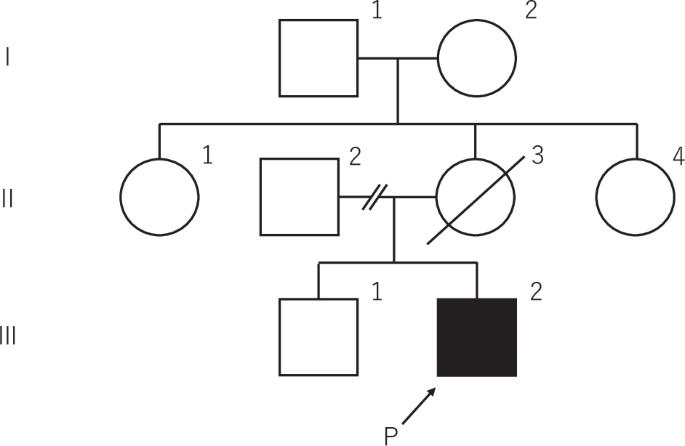小说m.14677线粒体tRNAGlu基因突变引起慢性进行性外眼肌麻痹。
IF 2.5
3区 生物学
Q2 GENETICS & HEREDITY
引用次数: 0
摘要
慢性进行性外眼麻痹(CPEO)是一种线粒体疾病,以进行性上睑下垂和眼麻痹为特征,由线粒体DNA (mtDNA)的单缺失、点突变或多重缺失引起。大多数点突变发生在tRNA基因中。在这里,我们报告了与CPEO相关的tRNAGlu基因的新变体。45岁男性,以上睑下垂和眼外麻痹为主;然而,血液测试结果,包括乳酸水平和自身抗体,都是正常的。CPEO暂停,进一步进行肌病理检查、mtDNA测序分析、长聚合酶链反应(PCR)分析和单纤维分析,以比较红布纤维(rrf)和非rrf之间的突变负荷。组织病理学检查显示分散的cox阴性RRFs。mtDNA未发现缺失。MtDNA测序分析在tRNAGlu基因中发现了一种新的变异m.14677 T > C, Sanger测序表明肌肉组织中存在45%的异质性。单纤维分析显示,RRFs中m.14677 T > C的突变负荷显著较高(范围:25.3-92.8%;平均:88.1%;n = 6)与非rrfs相比(范围:3.5-85.9%;平均:17.1%;n = 5) (P = 0.03)。基于RRFs中明显高于非RRFs的突变负荷、线粒体疾病的病理证据以及突变发生在进化保守位点,我们得出结论,tRNAGlu基因的一种新变体m.14677 T > C是CPEO的原因。肌肉组织的生化和组织病理学检查,结合单纤维分析,是评估mtDNA变异,特别是tRNA基因变异的有价值的工具。本文章由计算机程序翻译,如有差异,请以英文原文为准。

A novel m.14677 T > C variant in mitochondrial tRNAGlu gene causes chronic progressive external ophthalmoplegia
Chronic progressive external ophthalmoplegia (CPEO) is a mitochondrial disease characterized by progressive ptosis and ophthalmoplegia, caused by single deletions, point mutations, or multiple deletions in mitochondrial DNA (mtDNA). Most point mutations occur in tRNA genes. Here, we report a novel variant of the tRNAGlu gene associated with CPEO. A 45-year-old male presented with ptosis and external ophthalmoplegia; however, blood test results, including lactate levels and autoantibodies, were normal. CPEO was suspended, prompting additional myopathological examination, mtDNA sequencing analysis, long polymerase chain reaction (PCR) analysis, and single-fiber analysis to compare mutation loads between ragged-red fibers (RRFs) and non-RRFs. Histopathological examination revealed scattered COX-negative RRFs. No deletions were found in the mtDNA. MtDNA sequencing analysis revealed a novel variant, m.14677 T > C, in the tRNAGlu gene, with Sanger sequencing indicating 45% heteroplasmy in the muscle tissue. Single-fiber analysis showed a significantly higher mutation load of m.14677 T > C in RRFs (range: 25.3–92.8%; median: 88.1%; n = 6) compared with non-RRFs (range: 3.5–85.9%; median: 17.1%; n = 5) (P = 0.03). Based on the significantly higher mutation load in RRFs than in non-RRFs, pathological evidence of mitochondrial disease, and the mutation’s occurrence at an evolutionarily conserved site, we concluded that m.14677 T > C, a novel variant of the tRNAGlu gene, is the cause of CPEO. Biochemical and histopathological examinations of muscle tissue, combined with single-fiber analysis, are valuable tools for evaluating mtDNA variants, particularly those within tRNA genes.
求助全文
通过发布文献求助,成功后即可免费获取论文全文。
去求助
来源期刊

Journal of Human Genetics
生物-遗传学
CiteScore
7.20
自引率
0.00%
发文量
101
审稿时长
4-8 weeks
期刊介绍:
The Journal of Human Genetics is an international journal publishing articles on human genetics, including medical genetics and human genome analysis. It covers all aspects of human genetics, including molecular genetics, clinical genetics, behavioral genetics, immunogenetics, pharmacogenomics, population genetics, functional genomics, epigenetics, genetic counseling and gene therapy.
Articles on the following areas are especially welcome: genetic factors of monogenic and complex disorders, genome-wide association studies, genetic epidemiology, cancer genetics, personal genomics, genotype-phenotype relationships and genome diversity.
 求助内容:
求助内容: 应助结果提醒方式:
应助结果提醒方式:


